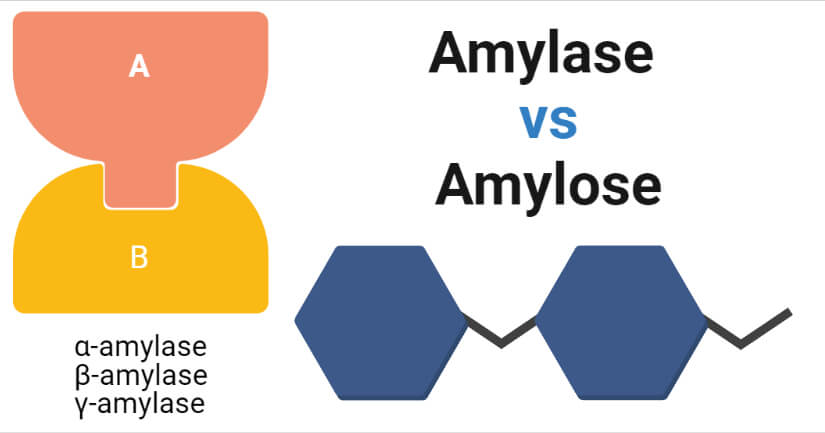Interesting Science Videos
Amylase Definition
Amylase is an enzyme that catalyzes the hydrolysis of starch to form smaller sugar units by breaking down the glycosidic linkages between glucose units.
- Amylases are of two types; α-amylase and β-amylase that hydrolyze α- and β-linkages present in the starch molecule, respectively.
- Besides α- and β-amylases, a third group of amylases called γ-amylases can also be found in the living systems, which cleave the glycosidic bonds present at the non-reducing end of the amylose and amylopectin.
- Starch is composed of amylose and amylopectin, which are linked together by α-1,4-glycosidic and α-1,6-glycosidic linkages.
- Amylase is a protein that is composed of a number of amino acid units linked together by peptide bonds.
- It has a complicated structure as it is categorized as a tertiary protein consisting of hydrogen bonds, hydrophobic bonds, disulfide bonds, and ionic bonds.
- All amylases are glycoside hydrolases that hydrolyze the glycosidic bond present within polymeric sugar molecules.
- Among all the amylases, α-amylases occur in the largest quantity in the human body. These amylases are produced by different glands throughout the body, like the salivary glands and the pancreas.
- Amylases are also produced by other animals, bacteria, as well as plants as carbohydrates, which are the primary source of energy in all living beings.
- The amylases break down polysaccharides into disaccharides and trisaccharides, which are then broken down into glucose and other monosaccharides by other enzymes so as to provide energy for metabolism.
- Even though the most important function of amylases is digestion in living systems, these amylases are also essential for industrial use in the food and beverage industries.
- Both α- and β-amylases are involved in the fermentation of starch-rich grains to produce alcoholic products.
- Amylase can also be used as a flour additive in breadmaking and other bakery techniques. These also have medical use in pancreatic enzyme replacement therapy to breakdown larger saccharides into simple sugars.

Amylose Definition
Amylose is a polysaccharide consisting of α-D-glucose units that are linked together by α(1→4) glycosidic bonds.
- Amylose is a part of polysaccharides like starch that is more resistant to digestion than other similar structures.
- The number of glucose units present in amylose ranges between 300-3000, but the number can range up to tens of thousands in some cases.
- Amylose is a polysaccharide where the monomeric units (glucose or other monosaccharides) are linked together by glycosidic bonds.
- Amylose is particularly important in substances like starch as it is resistant to digestion due to its helical structure. Besides, the linear structure of the molecules also requires less space. As a result, amylose can be store by plants for future use.
- The structure of amylose is comparatively less complex than amylase, but it can exist in disordered amorphous conformation or helical forms.
- Amylose constitutes about 20-25% of the total volume in starch, while the rest is composed of amylopectin, a different type of polysaccharide.
- Amylose is a linear chain structure without any branching. Thus, the molecule only contains the α-1,4-glycosidic linkage. During digestion, these linkages are broken down by amylases so that the monosaccharides can be digested during metabolism.
- Amylose contains α-D-glucose units where carbon 1 of one glucose molecule is bonded to the carbon-4 of the other glucose molecule.
- Amylases breakdown amylose into maltotriose and maltose, which can then be further digested to produce energy.
- Amylose can be detected in laboratories by using an iodine solution which results in a dark blue-colored solution, indicating the presence of amylose.
- These can also be used in industries as thickeners, water binders, and stabilizers in food and textile products.
10 Key Differences (Amylase vs Amylose)
| Characteristics | Amylase | Amylose |
| Definition | Amylase is an enzyme that catalyzes the hydrolysis of starch to form smaller sugar units by breaking down the glycosidic linkages between glucose units. | Amylose is a polysaccharide consisting of α-D-glucose units that are linked together by α(1→4) glycosidic bonds. |
| Biomolecules | Amylase is a protein. | Amylose is a carbohydrate. |
| Structure | Amylase has a complex tertiary structure. | Amylose has a comparatively simpler linear chain structure. But it can exist in helical structure when bonded to other molecules like lipids. |
| Linkages | Amylases consist of peptide linkages between the monomeric units. | Amyloses consist of glycosidic linkages between the monomeric units. |
| Bonds | Hydrogen bonds, disulfide bonds, ionic bonds, etc., are found in amylase. | Hydrogen bonds, disulfide bonds, and ionic bonds do not occur in amylose. |
| Monomeric units | The monomeric units present in amylase are amino acids. | The monomeric units present in amylose are D-glucose. |
| Found in | Amylases are produced by different glands in the form of salivary and pancreatic secretions. | Amylose occurs in starch as one of the major constituents. |
| Relationship | Amylase is an enzyme that breaks down amylose units. | Amylose is the substrate for amylase during metabolism. |
| Types | Amylases are of three different types depending on the type of bonds broken by the enzyme; α-amylase, β-amylase, and γ-amylase. | Amyloses are not divided into any such categories. |
| Function | Amylase catalyzes the hydrolysis of starch. | Amylose constitutes starch and acts as s storage carbohydrate in plants. |
References and Sources
- 1% – https://www.sciencedirect.com/topics/biochemistry-genetics-and-molecular-biology/glycoside-hydrolase
- 1% – https://wikimili.com/en/Amylose
- 1% – https://pediaa.com/difference-between-amylase-and-amylose/
- 1% – https://nph.onlinelibrary.wiley.com/doi/10.1111/nph.16858
- 1% – https://en.wikipedia.org/wiki/Amylase
- 1% – https://byjus.com/chemistry/amylose/
- 1% – http://www.differencebetween.net/science/health/difference-between-salivary-and-pancreatic-amylase/
- <1% – https://www.sciencedirect.com/topics/agricultural-and-biological-sciences/amylase
- <1% – https://www.difference.wiki/amylose-vs-amylopectin/
- <1% – https://www.askdifference.com/starch-vs-polysaccharide/
- <1% – https://onlinelibrary.wiley.com/doi/abs/10.1111/apt.15698?af=R
- <1% – https://diabetestalk.net/blood-sugar/is-glucose-a-monomer-or-a-polymer
